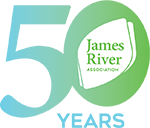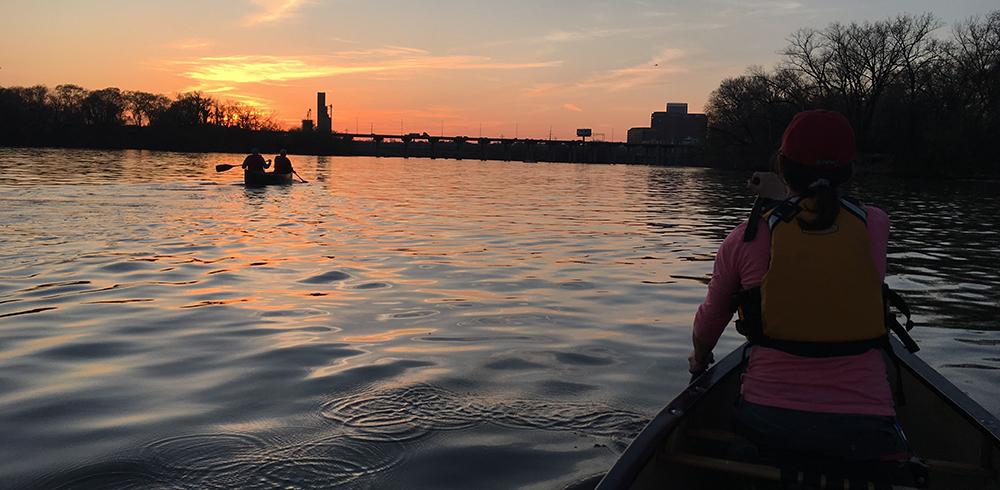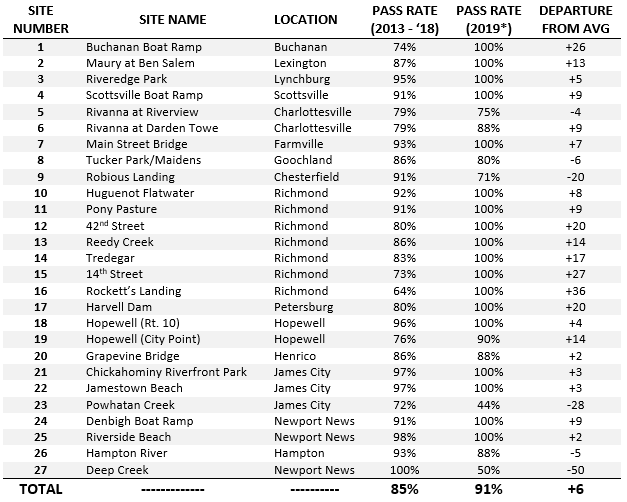James River Watch wouldn’t be possible without the committed volunteers that test week in and week out. We can’t thank them enough for their eagerness to learn and dedication to taking samples at every site, every week. So far this summer, our 80 Water Quality Monitoring volunteers have logged over 300 bacteria measurements across the watershed, and have accumulated almost 600 hours of volunteerism! Thank you all for your hard work!
This summer, the James and most of its tributaries have seen good river conditions. Let’s jump into the numbers. Across all measurements and all sites, our samples have passed state-assigned bacteria standards over 90% of the time! This is 5% better than our long-term average and better than last year’s results, recorded during the prodigiously wet summer and calendar year of 2018, from which we still expect to see some adverse effects.
For detailed results, check out the table above. Compared to long-term averages, the best performing sites are Buchanan, as well as Rockett’s Landing and the 14th Street take-out in Richmond. But it’s not all good news. Higher-than-average bacteria levels have been observed at Robious Landing (just west of Richmond), Powhatan Creek (near Williamsburg), and Deep Creek (in Newport News). These latter two locations are performing especially poorly this summer. The reasons are unknown, but let’s speculate…
Typically, we associate high E. coli levels with heavy rainfall, but we have not seen as many episodes of heavy rain this summer. So why the poor readings? The answer(s) probably vary site-to-site. Because of its location, Robious Landing is more likely to be affected by agricultural waste, while parts of the tidal James may be more affected by septic systems – which are more likely to fail as groundwater tables and sea levels continue to rise. In the medium to long term, we can expect this latter issue to become more and more problematic. And as far as agriculture, we need more money to install best management practices, and that’s why we need your help at the General Assembly!
Playing devil’s advocate for a minute, there’s uncertainty in any collection of data, but our duplicate sampling scheme is designed to minimize it. Wildlife can also be a significant source of bacteria pollution (think Canada Geese), but they usually aren’t the primary culprit. Bacteria levels can also be higher in confined waterways like Powhatan Creek, versus the bigger, cleaner, and better-mixed waters of nearby Jamestown Beach, which hasn’t had a failing bacteria sample since July of 2016.
The truth is that water quality is complicated and our river systems are complex, which hits at the purpose of James River Watch. So what can we do to achieve even better bacteria numbers? The answer is a river-mile long. The easiest fixes are picking up after your pet, and making sure that your septic system is in good working order. If you own property along a river or creek, make sure its banks are protected by streamside trees and shrubs. These help to lock bacteria and other pollutants on land, while providing critical habitat for terrestrial and riverine species. You can also sign up to be a RiverRat, paddling the river and reporting pollution issues like leaking sewage lines or illegal straight-pipes. Done all these things and still want to do more? Then check out some of our other simple steps you can take to protect the James!
The James and its tributaries continue to steadily improve, and we can’t do it without you. Whether you’re a RiverRat or a River Steward or the owner of a River Hero Home, you’re making a difference in your community. Whatever you can be, be a James Changer!


